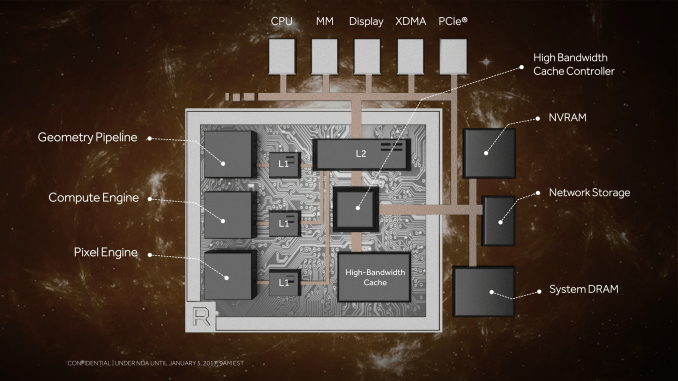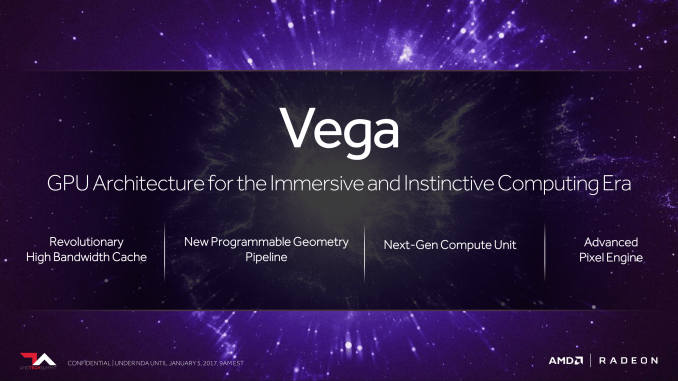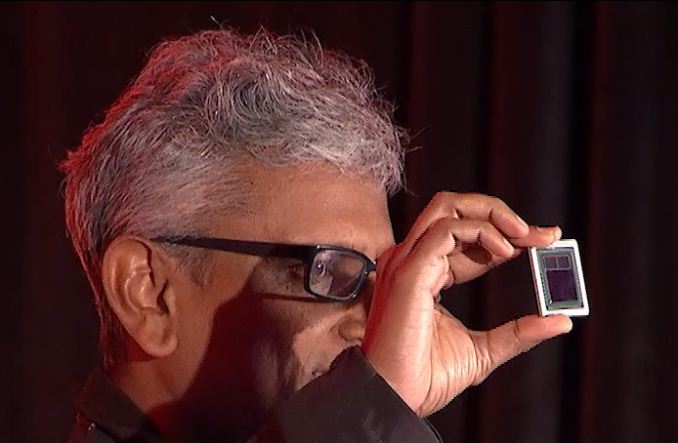The AMD Vega GPU Architecture Teaser: Higher IPC, Tiling, & More, Coming in H1’2017
by Ryan Smith on January 5, 2017 9:00 AM ESTFirst Thoughts: A Peek At What’s To Come
Wrapping things up, while today’s reveal from AMD is only a teaser of what they have been working on over the last few years with Vega, it’s none the less an important one. Based on what we know so far, Vega stands to be the biggest change to AMD’s GPU architecture since GCN 1.0 was released 5 years ago, and the changes to the ALUs, the ROPs, the memory structure, and other aspects of Vega reinforce this notion. To be sure, Vega is not a wholly new architecture – it is clearly a further refinement of GCN – but then this is exactly why GCN was designed to be able to evolve through refinements over a very long period of time.
What we have for now then is a quick look at what’s to come from AMD. There are still many things we don’t know, not the least of which is the actual GPU configurations. But for a teaser it’s enough to show that AMD has been hard at work. It sets the stage for the hardware and marketing ramp-up to come over the next few months.
But for now, let’s close with an image. As I mentioned before, the first Vega has taped out, and Radeon Technology Group’s frontman and Chief Architect, Raja Koduri, has one. The chip was just a few weeks old as of December, and while trying to discern die size may be a little too error-prone, we can see one important detail: 2 HBM2 packages.
Raja and AMD will not tell us what chip we’re looking at – like Polaris, two Vega chips have been confirmed – but either way we are looking at one of them in all its alpha silicon glory. Bearing in mind HBM2’s much greater bandwidth per pin, we could very well be looking at a design for a Fiji-like 512GB/sec of memory bandwidth in the chip Raja holds. And for AMD, that is one more teaser for today to keep attention focused right where they want it: on Vega ahead of its H1’17 launch.



















155 Comments
View All Comments
Michael Bay - Thursday, January 5, 2017 - link
It`s awesome when your GPU is not burning the whole computer up, true.TheinsanegamerN - Thursday, January 5, 2017 - link
Hence why you do not buy GTX 480s.lobz - Thursday, January 5, 2017 - link
u got burned by your fermis, didn't you? =}LordanSS - Saturday, January 7, 2017 - link
My old FX 5800 was the loudest, hottest card I've ever owned. I didn't own a Fermi but I've read those weren't very nice either.silverblue - Thursday, January 5, 2017 - link
I'm not sure I follow. Are you saying that David Kanter's discovery forced AMD to bake TBR into Vega?wumpus - Thursday, January 5, 2017 - link
Looks that way, but the timeline is impossible. What drove both Nvidia and AMD to tiling was that HBM memory wasn't working and they need serious bandwidth to the framebuffer. Tiling is an obvious way around that issue.AMD just found out that HBM wasn't going to work a generation late (because FuryX never took off. And probably will *still* need to tile if they use HBM2).
xenol - Thursday, January 5, 2017 - link
And congrats to NVIDIA for using a 12 year old design finally.Tiled rendering is ancient in computing terms. It's at least as old as the Dreamcast which had that PowerVR GPU that did tiled rendering.
BrokenCrayons - Thursday, January 5, 2017 - link
Pre-Dreamcast actually. PowerVR's second generation video processor was in the Dreamcast, but the first generation was relased to market on a 32-bit PCI card and chips were out on the market in 1996 making the concept of tiling about 20 years old.TesseractOrion - Thursday, January 5, 2017 - link
I had a first generation PowerVR card add-in card (supporting a generic 2d card) and later, a PowerVR Kyro (I think it was called). Was it Imagination Technologies? Can't be bothered to look it up LOLBrokenCrayons - Thursday, January 5, 2017 - link
Yup the first PowerVR card didn't work as a standalone graphics adapter. I had one too from Matrox, IIRC. It worked pretty well in original Unreal (non-tournament version). I had a lot of fun on Deck 16 with that thing until I replaced it and the S3 ViRGE DX with a Diamond Viper V550 and a Voodoo 2. It was good for 640x480.You're right that their later iterations were sold under the Kyro branding. I sold one of them from my computer shop inside of a custom built desktop...well actually, it was a Kyro II not the original. The techs tinkered with it a little during build, but I didn't get a chance to mess with it. The other partner and I were pulling several miles of wire in one of our business client's new offices so it was out the door before I got more than a glance in passing at what it could do. It was fairly competitive with a GeForce 2 if you put enough CPU power behind it (I think it lacked hardware TnL so it needed the processor power).